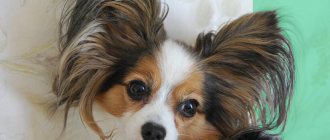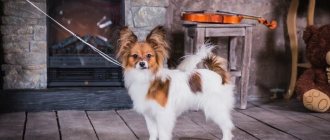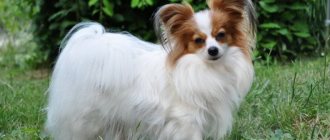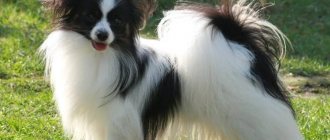Breed characteristics
| Short description | |
| Origin: | France, Belgium |
| Conditions of detention: | House, apartment |
| Purpose: | Decorative dog and companion dog |
| Color: | White with spots of various colors (except blue), black with tan |
| Wool length: | Long |
| Adult dog size: | Height – 28 cm, weight – 1.5-5 kg |
| Average life expectancy: | 14-18 years old |
| Walk: | Need two walks a day |
| Physical activity needs: | Average physical activity needs (walking 1 to 3 hours per day) |
| Fédération Cynologique Internationale (FIC) classification: | Group 9: decorative and companion dogs; Section 9: Continental Toy Spaniel and Russian Toy |
| Puppy price: | From 12,000 to 80,000 rubles. Without pedigree - 12,000-15,000 rubles, pet class - 20,000-30,000 rubles, breed class - 40,000-60,000 rubles, show class - 70,000-80,000 rubles |
Japanese Chin
The Japanese Chin is a natural companion. These are sophisticated, very delicate and clean dogs. This breed is also sensitive and sentimental, and the Chin can become depressed if neglected. Showing love to members of its family, the chin needs reciprocity, and does not tolerate indifference and rudeness. Japanese Chins like to keep their owners in sight at all times.
1 of 6
This breed is calmer and more reserved compared to other decorative dogs. Chins are active and playful in moderation and require minimal physical activity.
The Japanese Chin has a silky long coat. Varieties of colors: spotted, white and black and sometimes white and brown. Their weight is 2-5 kg, height - 20-27 cm.
In general, these are cheerful creatures, intelligent, understanding and delicate, they get along well with other pets.
History of the origin of the species
The Papillon is a French breed, as evidenced by the name itself, which is translated from French as “butterfly”. Dog handlers are inclined to believe that the closest relatives of these dogs are dwarf spaniels, which is why the breed has a second name - Continental Toy Spaniel.
There is still no exact time when the breed was bred . About 800-1000 years ago, the first similar dogs appeared in the paintings of artists, such as Titian (“Roberto Strozzi’s Daughter”). In addition, they were depicted in portraits of nobles and royalty. Papillons were the favorites of Marie Antoinette, Henry II, Louis XIV, and the Marquise de Pompadour. Kings spent fabulous sums so that a cute dog could share moments of joy and sadness with them.
After the French Revolution, Continental Spaniels were destroyed as a symbol of the bourgeoisie. Therefore, the breed almost became extinct, but was restored in the 18th and 19th centuries.
In the 20s of the 20th century, dog breeders and cynologists crossed the breed with Spitz. Thanks to this work, the spaniels' coat has improved and acquired a new silky appearance. In 1934, the first standard was approved, after which Papillons spread throughout the world.
Interesting facts about Papillons
- The Papillon dog breed is included in the top ten ranking of the smartest dogs.
- Once you get a Papillon, you won't be able to choose another breed.
- Representatives of this breed are capable of experiencing emotions inherent in humans. Among them: jealousy, love, resentment, joy. Each state of a dog can be easily counted by its face.
- Papillons are incredibly loyal to their owner. Marie Antoinette's dog, named Coco, accompanied the queen until her death, running out to her owner's execution.
- Papillons understand human speech well.
- After the revolution in France, Papillons were killed because they were associated with the bourgeoisie.
Distinctive features
A truly royal dog with graceful movements and a slightly arrogant appearance. Papillons are distinguished by their elongated body format, pointed muzzle, long hair and small size. As a rule, both males and females reach 28 cm , but they weigh differently: from 1.5 kg to 5 kg.
The standard distinguishes between two types of Continental Spaniels: Papillon (butterfly ears - erect) and Phalene (dropping ears). In all other respects, both subspecies are almost the same. However, crossing them is prohibited because the puppies end up with semi-erect ears.
- The head is small, light, but proportional to the body. The skull is not too round, the furrow between the eyes is visible. Stop is expressed.
- The muzzle is short, narrowed, the bridge of the nose is straight. Cheekbones are filled, cheeks are flat. The jaws are strong with a scissor bite. Thin lips pressed to the jaws.
- The nose is small and round.
- The eyes are large, almond-shaped; set low and wide. The inner corner of the eye is in line with the stop. The color is dark brown, the eyelid is pigmented.
- Ears . Papillon : ears stand on hard cartilage, set high, rounded at the tips, set at 45° to the horizon, covered with thick flowing hair. Phalene : Ears are set high, drooping and close to the head, surrounded by thick, flowing hair.
- The body is more elongated than square. The topline is straight, the back is strong and short. The loin is rounded, the croup is not sloping. The chest is wide and deep with rounded ribs. The belly is well tucked. The neck is curved, of medium length.
- The tail is high set, quite long, carried over the hip or lower back, but does not form a ring. Surrounded by long hair that forms a fountain.
- The limbs are set parallel and straight. Quite strong and muscular. The paws are long, like a hare's. The fingers are well developed and mobile. The movements are graceful, proud, light.
- The coat is wavy, thin, flowing and shiny. Quite thick, no undercoat. The hair is short on the body and head, frilled on the neck, and elongated on the ears and tail. Feathering on the limbs is characteristic.
- The color is white with spots of any color. The head should always be dark.
Description
The Continental Toy Spaniel breed standard carefully describes all its characteristics. Dwarf animals are distinguished by their compact, strong, but at the same time graceful physique. Miniature pets grow up to 28 cm and gain body weight from 2.5 to 5 kg. The lifespan of a Continental Toy Spaniel is up to 14 years.
According to the current breed standard, dogs must have the following characteristics:
- long thick coat with a characteristic shine, without undercoat, with a curl;
- color – spotted, always on a white background, the shape and color of the marks are not regulated, a snow-white mark on the forehead is desirable;
- thin-boned limbs with hare-type feet, hard paw pads;
- a high-set, well-furred tail that curls over the back when the animal is excited;
- the body is compact, the lower back is slightly convex, the groin is slightly tucked;
- wide, clearly defined chest, arched forward;
- ears set wide apart, thin, covered inside and outside with long soft hair;
- the eyes are low-set, almost at the bridge of the nose, almond-shaped, rather large, dark brown in color;
- lips are brightly pigmented, dry, tight-fitting;
- the teeth are white, on strong jaws, closed in a scissor bite;
- the skull is slightly rounded, with a clear stop and median groove, a pointed muzzle;
- the nose is black.
Continental toy spaniels with obvious defects in appearance are classified as breeding dogs. These include non-closing of the jaws, behavioral vices - cowardice, aggressiveness. A flat skull, too small or excessively protruding eyeballs are considered undesirable. A brown or depigmented nose, a distorted bridge of the nose, and the presence of pink spots on the eyelids are considered defective.
By its temperament, the Continental Toy Spaniel is a balanced, calm dog that can be affectionate with its owner and distrustful of strangers. The animal has a cheerful, playful disposition, loves entertainment and active pastime, and gets along with children. You can purchase it as a companion and get a devoted companion for many years.
In the absence of proper attention to them, Phalenas and Papillons are quite jealous - you can compensate for this by taking two puppies at once, who will brighten up each other’s leisure time in the absence of the owner.
Photo of an adult dog
Photos of puppies
Features of character and behavior
It is worth noting that this breed is one of the smartest on the planet (ranked 8th). Therefore, Papillons are easy to train and raise. Dog breeders claim that such spaniels are bundles of energy, perpetual motion machines - optimistic and active. Pets become real friends for children and adults. They are very playful and cheerful; it is rare to meet a sad or dissatisfied spaniel. However, it is still a dog.
The Papillon has a sense of self-esteem and is prone to dominance and manipulation. Without proper training and socialization, such a cute dog can become aggressive and uncontrollable.
Advantages
- Continental Toy Spaniels are loyal and devoted dogs who will never trade their family or run away. They are attached to the owner and household members, love children and can protect them with loud barking.
- Despite its small size, this dog’s guard instincts are well developed.
- Many breeders claim that Papillons easily make friends with other pets.
- They are playful, active and optimistic . An activity can be found anywhere and at any time.
- The positive side is independence; most often the spaniel does not need anyone to play with, although he will not refuse to run after a ball or stick.
- They are inquisitive and very smart, they sense the mood of the owner. These dogs can support you in difficult times, calm you down and cheer you up. They will not impose themselves, but attracting people’s attention is one of the main tasks of such a pet.
Flaws
- They require training and education. Papillons have a multifaceted character. They can become aggressive and angry without proper socialization in a timely manner. Cute puppies love to sit on the neck and manipulate the owner, often occupying the position of leader in the house.
- They cannot stand loneliness. Such a pet cannot be left at home for a long time. He will start whining and moping in boredom. Therefore, this breed is not suitable for constantly working and busy people.
- Touchy and vindictive. Continental Spaniels will remember everything that they didn’t like during training or communication and are unlikely to forgive someone who once harmed them.
Yorkshire Terrier
An English decorative breed that originated in Yorkshire. Presumably, the ancestors of Yorkies were Waterside Terriers. These dogs were kept by the peasants of the county in the 18th and 19th centuries, as it was forbidden to have larger dogs for fear that people would start poaching.
Check out the popular representatives of terriers in two parts: and.
Small dogs exterminated rodents in houses and were always near their owner, wherever he went. Active industrialization forces peasants to go to cities in search of work. Of course, you can take your pets with you.
In 1898, the York Club was organized. By the forties of the last century, the popularity of doggies had decreased significantly. And only in the last years of the war they became interested again, thanks to the dog Smokey.
Did you know? Smokey was found by the US military in New Guinea. With them she experienced many military events. Considered the first
“
medical dog
”
, as she helped nurses in the hospital care for the sick.
Her “career” lasted 12 years. These cute dogs, considered the smallest, have a bold and courageous character. They are very curious and restless. They are always loyal to their owner and are in great need of his attention and care. Ready to follow the owner everywhere
They can be very persistent if they want to get attention or food from their owner. Find a common language with all the inhabitants of the house
They love to run, jump, and frolic. They enjoy chasing a ball, butterflies, and birds.
They might catch a rat or a mouse. During walks, be careful not to let your pet get carried away by eating insects and rodents. Their delicate stomachs are not ready to accept large quantities of such food.
Yorkies do not get their silver coat right away. They are born black and begin to lighten with age. Along with this, changes occur in the structure of the hairline - the fur coat becomes straight, thin and silky.
To care for the fur, you will need a clipper and a furminator.
Care and maintenance
Caring for a Papillon is no more difficult than caring for any decorative dog. They shed twice a year, so taking care of a clean, beautiful coat is a priority on the list of procedures. To do this, you need to comb the dogs, bathe them in a timely manner and cut their hair (if they are not participating in exhibitions).
Continental Toy Spaniels are suitable for domestic life only. Street maintenance is impossible not only because of its miniature size. This breed does not have an undercoat, so the dogs get cold in winter and can overheat in summer. Such small animals can be kept in an apartment; the Papillon does not need a lot of space. He can adapt to a home toilet, but this will not be a full replacement for walking.
- After changing teeth, you need to brush your incisors every two weeks with a soft brush and special toothpaste. Chewing cords can be used.
- Claws are trimmed with a nail clipper once every 2-3 weeks.
- Eyes and ears are examined daily. Cleaning the ears is not a frequent procedure ( 3-4 times a month), but the eyes should be washed with chamomile decoction every 5-6 days.
- Before buying a puppy, you need to equip the house, purchase the necessary items for daily use: a bed, brushes and combs, hygiene products, toys, bowls on adjustable stands. Usually such miniature dogs sleep with their owners, but it is better not to accustom them to this.
Nutrition
Papillons are small dogs, so feeding them will not be expensive. If the breeder advises feeding the puppy the same thing that he was fed in the kennel, then you should listen. Otherwise, the transition to another food should be smooth.
- Increasingly, dog breeders prefer dry feeding. It is easy to use and contains a complex of essential vitamins and minerals.
- You need to choose holistic (grain-free) super-premium for small, active breeds.
- In case of allergic reactions, you need to subtract the composition and change the product to a hypoallergenic one.
- Typically, an adult Papillon needs 200-300 grams of dry food per day. It needs to be diluted with warm cold water or broth for better absorption.
- With a natural diet, the diet should consist of 50-60% meat and offal. Lean beef, lamb, rabbit and chicken are perfect.
- Another 30% is occupied by porridge cooked in broth or milk. The rest of the menu should be filled with fresh vegetables and fruits, dairy products, boiled boneless sea fish and boiled eggs.
It is strictly forbidden to feed Papillons the following foods:
- Pork;
- Butter;
- Fatty dairy products;
- Bones;
- Fried;
- Floury and sweet;
- Potatoes, melon, grapes, garlic and onions;
- Smoked;
- Nuts and beans.
Feeding mode:
Papillons are quite active, so they need to be fed 2 times a day . In hot weather, the portion size is reduced, but more water is poured, which should always be freely available. Food should be warm and liquid. Puppies are fed more often - 5-6 times a day. From an early age, the puppy is given vitamins prescribed by the veterinarian.
Health
Papillons are long-lived . The average lifespan is 15 years , but some individuals reach 18-20 years . But this breed cannot be called completely healthy. Continental Toy Spaniels are prone to many diseases, some of which are hereditary. Particularly problematic areas are the eyes and nose, respiratory tract and joints.
To avoid diseases or at least not worsen them, you need to properly care for the animal, follow the schedule of vaccinations against infectious diseases and notice any changes in the behavior and well-being of the pet.
Vaccinations
All pets must be vaccinated on schedule. For dogs, there are 2 main vaccinations that must be renewed annually in the same month.
- The first vaccination is usually carried out in the nursery when the puppies reach 1.5-2 months . Then the procedure must be repeated after a few weeks, at 6 months and 12 months . A complex drug is introduced that will protect the puppy from viral diseases and give him immunity.
- The second important vaccination is against rabies . It is carried out at 7 months . Some breeders believe that this vaccination is not necessary if the puppy does not come into contact with unknown animals. But without this vaccination, the dog cannot be taken abroad. In addition, if a pet bites its owner and does not have this vaccination, then problems with medical care may arise (doctors will not hesitate to begin treatment; it is impossible to prove that the pet is healthy).
For vaccination to go well, you need to rid your pet of helminths in advance (two weeks before) using special medications. The dog must be absolutely healthy. Pregnant and lactating females, males after mating and weakened, exhausted pets are not allowed to undergo the procedure.
- The puppy cannot be walked until the second vaccination.
- After each procedure, you must quarantine for 14 days .
- The cost of vaccination varies from 400 to 1000 rubles.
Vaccination does not provide a 100% guarantee that a dog cannot become infected with a viral disease. Therefore, if there is a sharp deterioration in your pet’s well-being, refusal to eat and play, or unpleasant symptoms (vomiting, diarrhea), you must contact the clinic without delay.
Diseases
Like many decorative breeds, the Continental Toy Spaniel is susceptible to some eye diseases, which can be either congenital or acquired:
- Cataract (damage to the lens);
- Entropy or entropion of the eyelid (sometimes solved only by surgery);
- Retinal atrophy (most often occurs in older pets);
- Papillons are prone to excessive tearing, so symptoms of conjunctivitis .
In addition, improper breathing is considered a breed problem: reverse sneezing, coughing, grunting and snoring. These symptoms are not normal and require treatment.
One of the most dangerous hereditary defects is weak ligaments and muscles. Because of this, spaniels are often injured: they suffer dislocations of the kneecaps, ruptures of muscle tissue.
Walk
Papillons are very active dogs.
- Walking should be twice a day and long ( 1-1.5 hours ).
- If your pet has the opportunity to walk freely around the garden, then active walks can be reduced to 40 minutes. In any case, this perpetual motion machine needs to splash out energy.
- Continental Toy Spaniels are not prone to aggressive behavior, but early socialization and familiarity with other pets will help instill in the dog restraint and courtesy in communication.
- These dogs will happily play with dogs and people if they are not angry . Otherwise, Papillon can fend for itself.
You need to walk both on a leash and without it. If the puppy runs away, then you need to scold him and deprive him of treats. Spaniels are smart enough that they will understand that this cannot be done. In hot weather, you should always have drinking water with you for your pet, and in the cold season, put protective overalls on your dog.
Grooming
Toy spaniels are quite clean and do not like dirt both around and on themselves. Therefore, it will not be difficult to accustom your puppy to hygiene procedures.
- Long, thick wool is combed every 2-3 days ; special products can be used to untangle tangles.
- During the shedding period (for males spring and autumn, for females after the birth of puppies), brushing should be done more often.
- Dogs do not have undercoat, so there will be no problems with a large amount of hair on furniture and carpets.
- If the dog does not participate in exhibitions, it is recommended to periodically do a hygienic haircut (between the fingers, genitals, ears and around the anus).
- During the summer, many breeders cut their dogs short.
- Bathing is carried out as soiled, with special shampoos no more than once a month . You can use dry shampoos. After each walk, paws are washed under warm water.
Do not forget about treatment against external and internal parasites (ticks, fleas, helminths). As a rule, it is carried out once every 1-2 months . In order not to get confused about the dates, you can record the drugs in the veterinary passport on special pages.
Color
The main requirements for the color of an animal are:
- the white background on the limbs, paws and body dominates the colored spots;
- it is desirable to have white star-shaped spots on the head;
- A white blaze is allowed at the front of the lower part of the head;
- white ears without colored spots are considered a fault;
- The spots themselves on the muzzle and head should be symmetrical.
The color itself comes in three types: white and red, black and white and white with black red spots. Breeders also distinguish between: lemon-sable, black-sable, white-lemon and snow-white colors.
Preference is given to dogs with two-tone coat color. Defects include white hairs inside the ears, lack of colored spots above the eyes and ears, liver and blue markings.
It should be noted that the color of a Papillon's coat may change after six months of life. Also, the color may change slightly after seasonal molts.
Mating
Papillons are not rare, but they are quite expensive dogs. Mating can be carried out at home, but if the bitch is a breeder and has a pedigree, then you need to contact the nursery to obtain a certificate. You need to look for a male dog in advance and agree on a date with the owner. The boy should not be larger in size than the female to avoid complications during childbirth.
Puppies become sexually mature early (8-10 months). Usually at this time the first signs appear: estrus in females and attempts to mount in males. It is recommended to untie only at 20-25 months , when the dogs are old enough to conceive and bear healthy offspring. Then the bitch will be in her third heat, the most favorable days are 13-15 from the beginning of the cycle.
The girl is brought to a male dog, or the dogs are brought together on neutral territory. You can walk your pets together to give them time to get to know each other and play. If the female is satisfied with everything, she will allow the cage to be made. Otherwise, you can try again every other day or choose another male. Sexual intercourse does not last longer than 5-10 minutes . At this time, the girl is supported by the head and under the stomach, and the boy is directed into the noose. If a lock has formed, the pets can be turned with their tails facing each other so as not to injure the genitals.
After mating, the male dog needs to be fed well and the girl needs to be calmed down. The next meeting should take place in 2 days. The progress of pregnancy can be checked at a veterinary clinic.
Key points in training
Papillons are one of the most intelligent breeds and are easy to train and suitable for beginners. But often such spaniels try to dominate and show character, so the owner should show the puppy who is boss in the house. This can be done without brute force or punishment, for example, the main method is feeding after all family members and prohibiting free movement on furniture. The dog must know its place in the house and in the family hierarchy, respecting all members of the household.
Read about how to properly train a dog in the article: “Training a puppy: effective methods from dog handlers, learning commands at home.”
Continental Toy Spaniel puppies are smart and curious, so they quickly learn names and commands. They also sense the owner’s mood and try not to upset him. From 4 months, when the dog already knows the daily routine and nickname well, you can learn the commands “Near”, “Place”, “Sit”, “No” . Papillons show good results in agility (obstacle course).
Nutrition
Mini spaniels are always surprisingly active, so they spend a lot of energy, which is replenished with high-calorie, quickly digestible food. When feeding puppies and adults, important rules should be followed:
- if the diet is dominated by purchased food, then the dog should have constant access to fresh and clean water;
- Along with food, the body receives beneficial vitamins and minerals, so the diet should be filled with these elements as much as possible;
- It is recommended to feed the baby only with warm foods;
- food from the master's table is taboo for spaniels;
- The Papillon digestive system does not digest raw meat well, so it is combined with vegetables;
- It is recommended to check your weight monthly to understand when you need to make changes to your diet;
- After eating, the dog should be given 20-30 minutes of rest, and should be taken for a walk after a while;
- food is selected carefully; preference should be given to high-quality varieties suitable for mini dogs.
Expert opinion
Anna Abramenko
An avid dog lover. Experience in veterinary medicine since 2009.
Ask a Question
During the summer heat, children's activity decreases, so the portion size decreases, but more water is needed.
How to choose a puppy
The Papillon is a fairly expensive dog, so many people buy puppies from private individuals . Most often, such pets do not have a pedigree, vaccinations or passport, and there are also no guarantees for the purebred and good health of the baby. All necessary documents are prepared at the official nursery. The breeder will tell you about the conditions for keeping the puppies, their regime and diet. In addition, there is an opportunity to evaluate the dogs' parents.
- Healthy puppies will be playful and curious.
- They must meet the characteristics of the standard and not have congenital pathologies.
- The cost of such a pet depends on its class.
- Without a pedigree, a puppy will cost 12,000-15,000 rubles, pet class - up to 30,000 rubles, breed class and show class - from 60,000 rubles.
- First of all, you need to decide for what purpose you are buying a dog. If as a pet, then a pet is suitable, and if for breeding and exhibitions, then a show class.
Reviews
Maria: “The breed shows amazing intellectual abilities. Our Baby is very inquisitive, but does not allow himself pranks and excessive aggression. It’s enough to explain to him the rules of behavior, he will look, listen and understand everything.”
Ekaterina: I wanted a miniature dog for a very long time, when they gave me this furball, I was in seventh heaven. Now for me this is not just a pet, but a real friend with whom I can be sad and have a lot of fun.”
Valeria: At first I thought that caring for a Papillon requires a lot of effort, but in reality the dog does not get dirty, keeps its fur completely clean, does not shed and has no characteristic odor. Several times a week I comb Bruno with a brush, and when he gets dirty, I bathe him using a special shampoo.”
Falen
A miniature decorative dog that is completely similar to the Papillon both in appearance and temperament. It arose around the same time as the Papillons, and lived in the palaces of the kings.
The only, but very significant difference is the shape and position of the ears . If the “butterflies” have ears that stand up and form a silhouette similar to a moth, then in the second dogs they hang down, like all spaniels, but are set high and are supported by cartilage. This external feature is where the name “ fallen ” comes from in English – falling, falling.
Phalene also belongs to the Continental Toy Spaniel breed and is included in the same standard. These dogs are perfect for apartment living, they are smart and active like Papillons. Both species participate in exhibitions and competitions on equal terms. Breeds should not be mixed to avoid semi-erect ears.
- The price for such a dog from a kennel will be from 60 to 80 thousand rubles
- From private breeders from 25 to 30 thousand rubles
Photo of a dog of the Falen breed
Buying any dog is a joy. Because these animals become best friends and life partners. Miniature dogs like Phalen and Papillon are especially held in high esteem because they get along well in a small area.
4.7 / 5 ( 3 voices)











